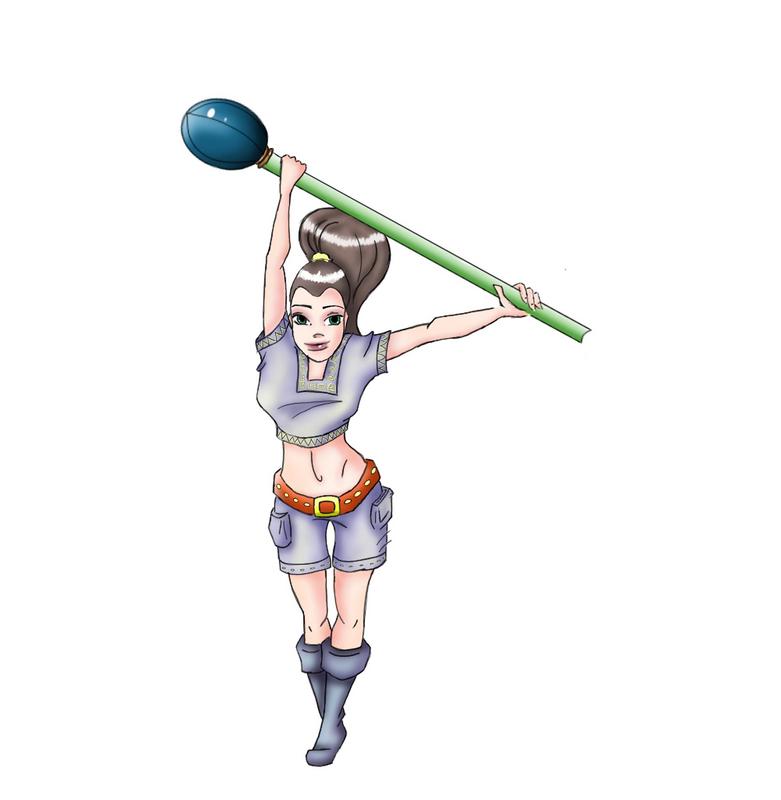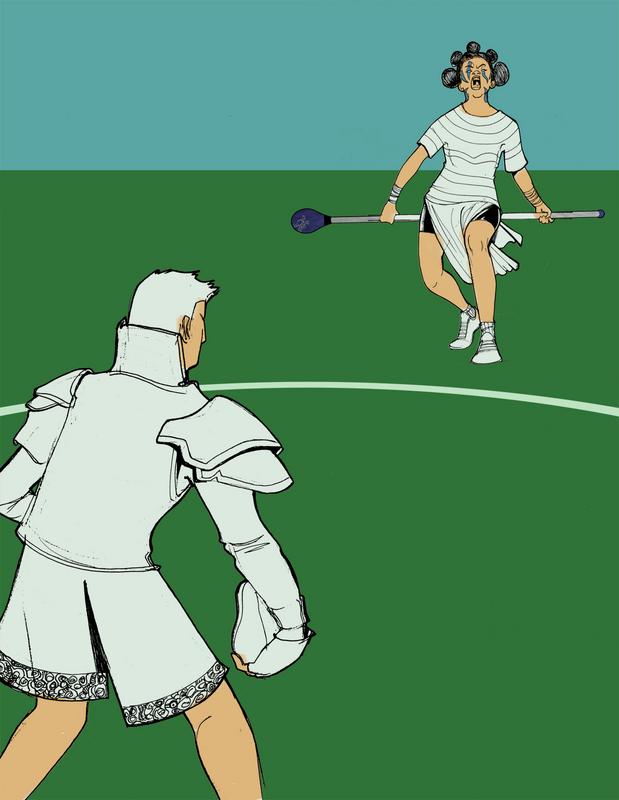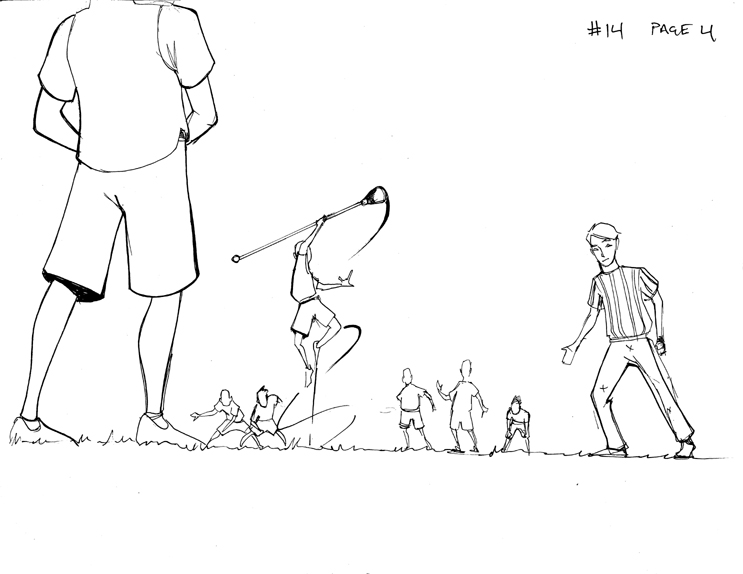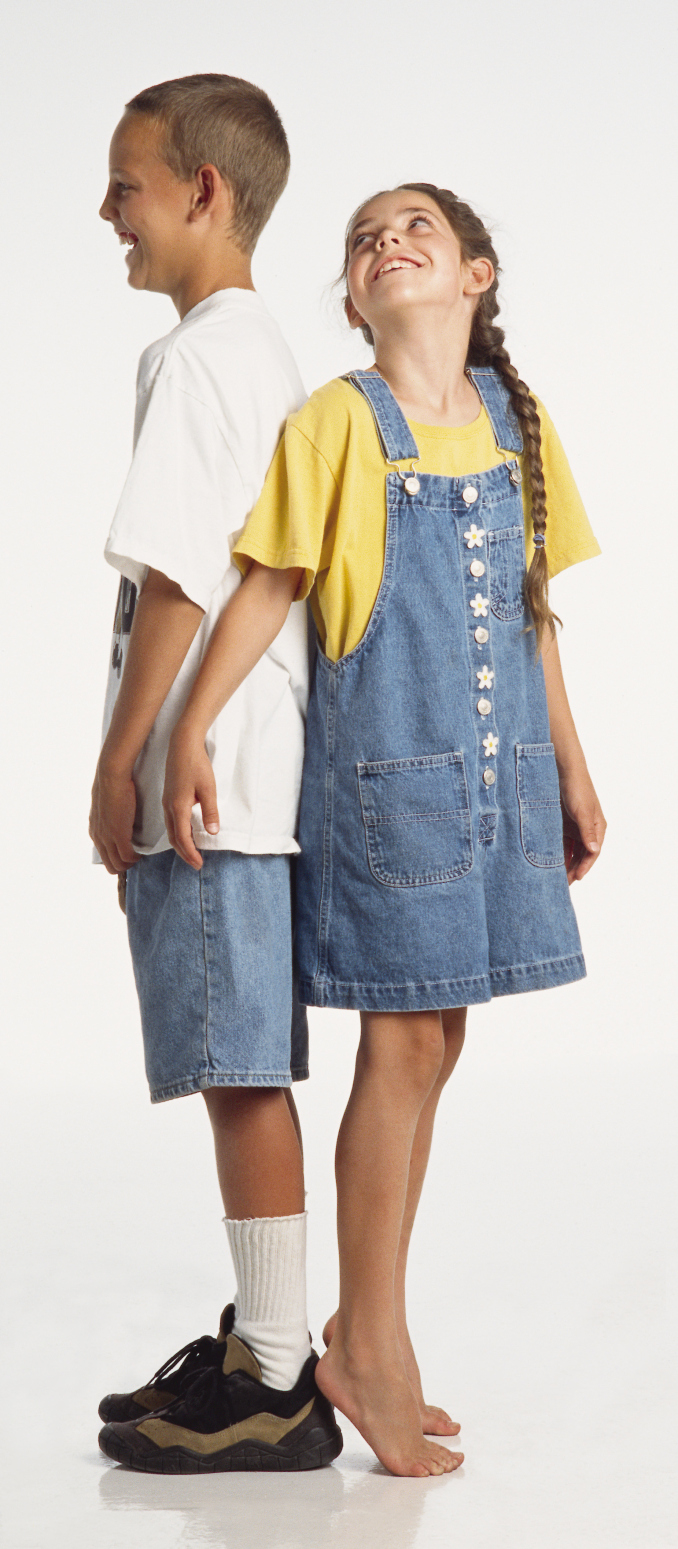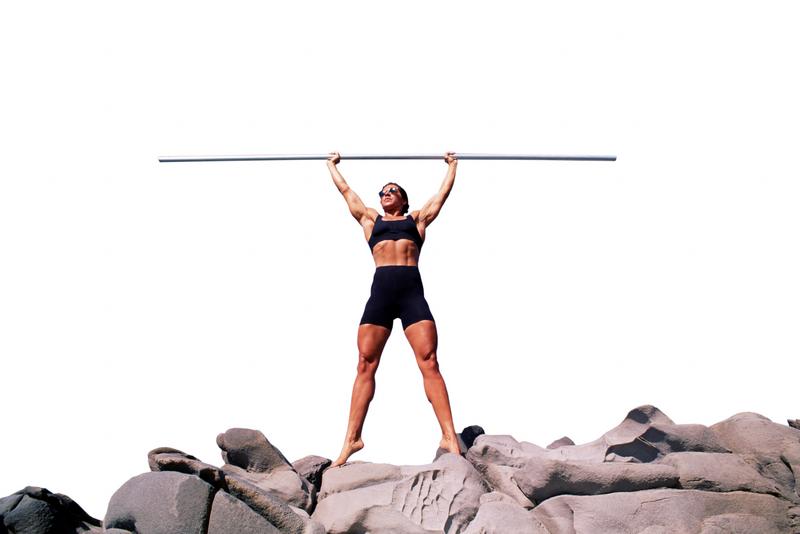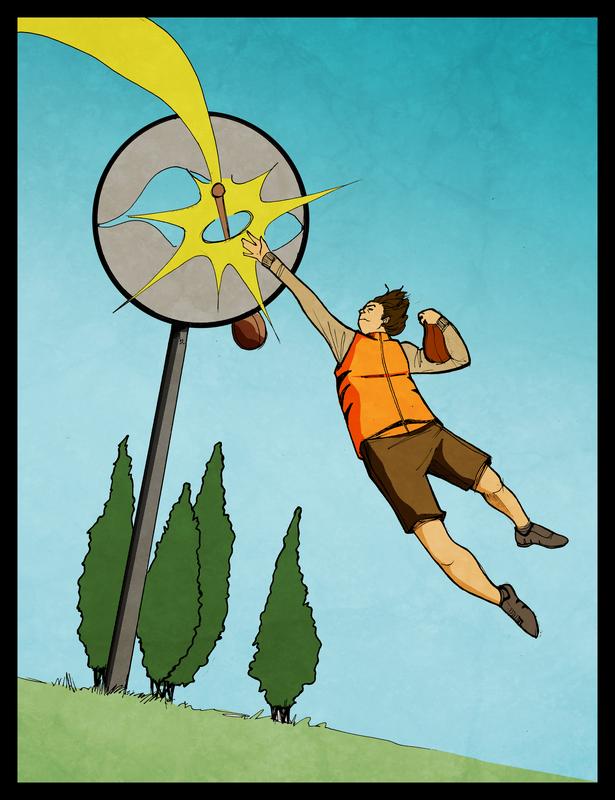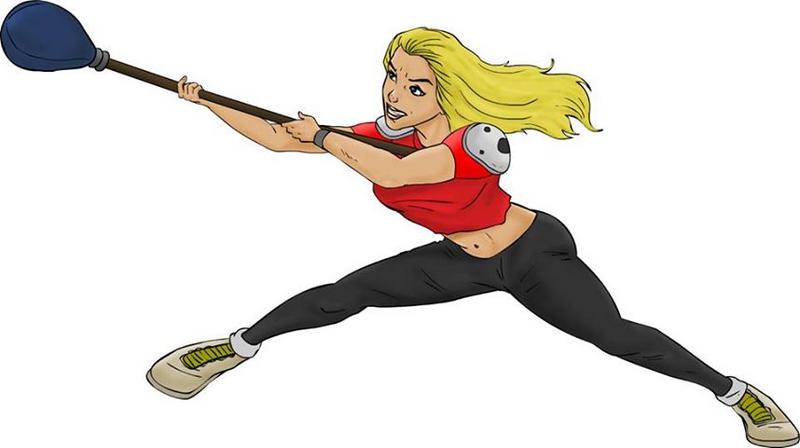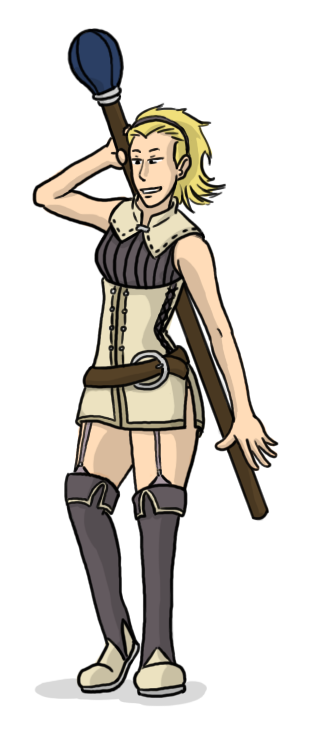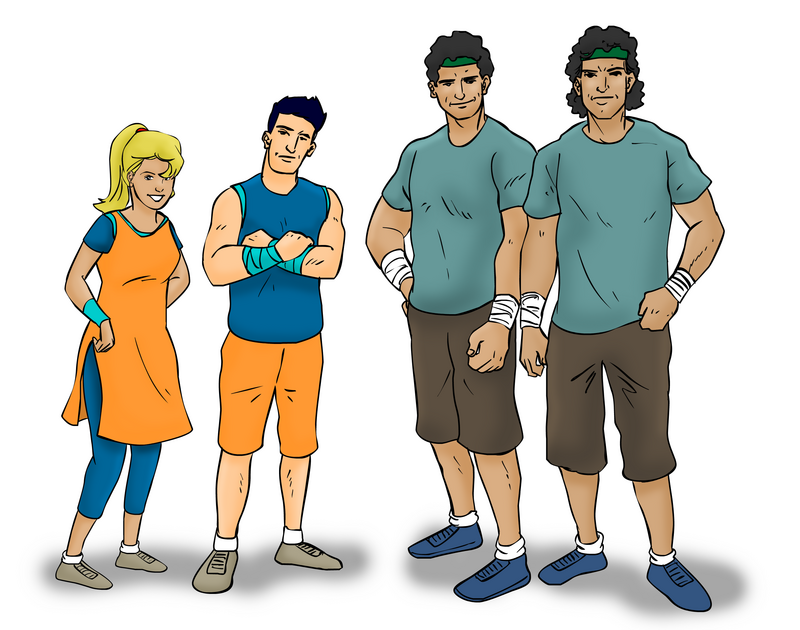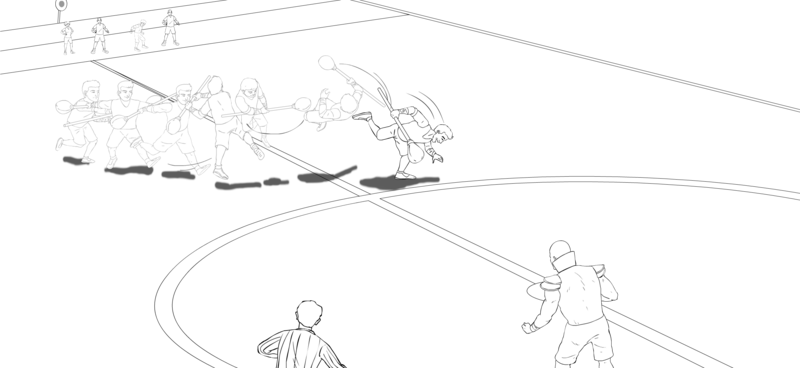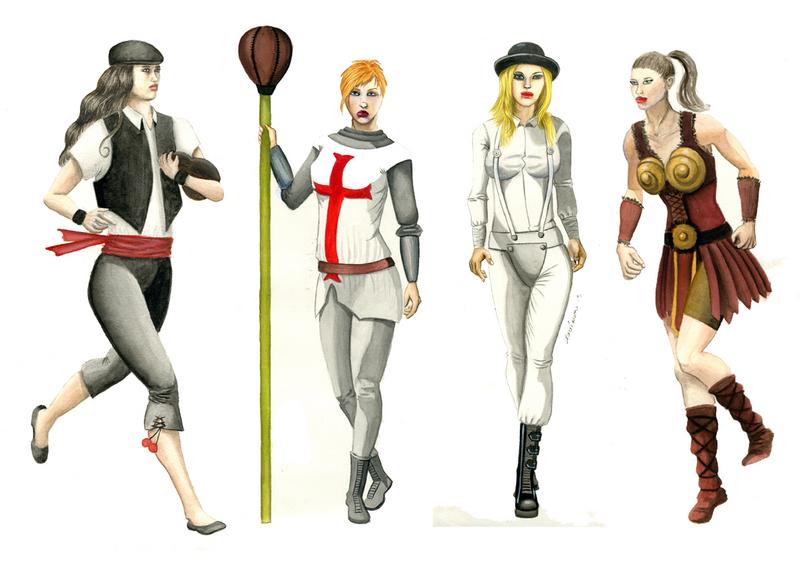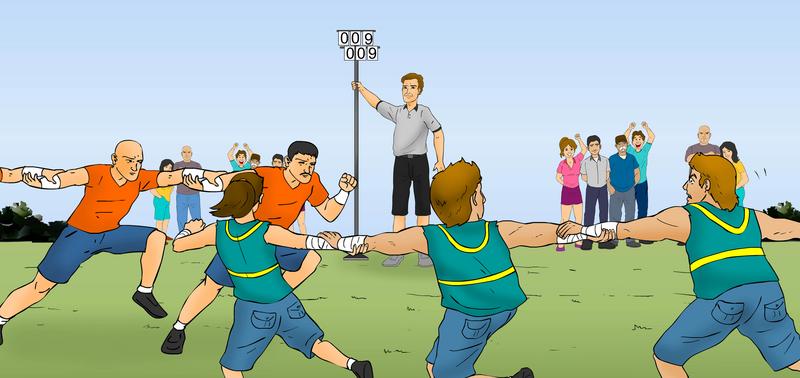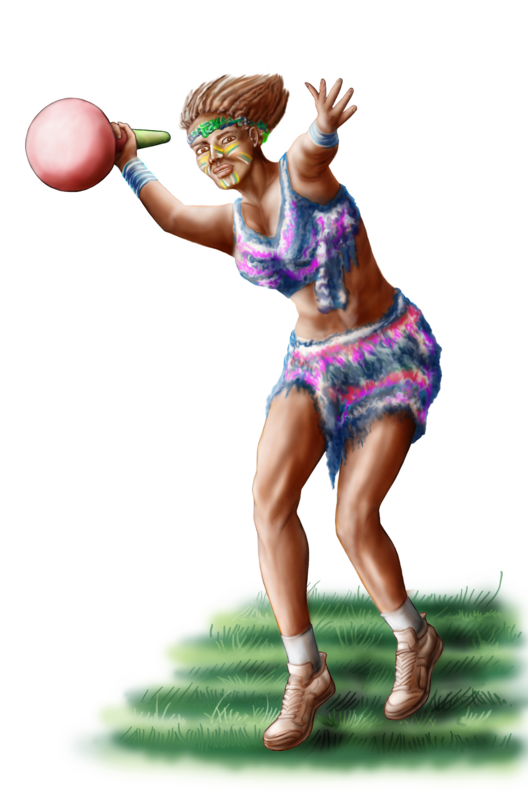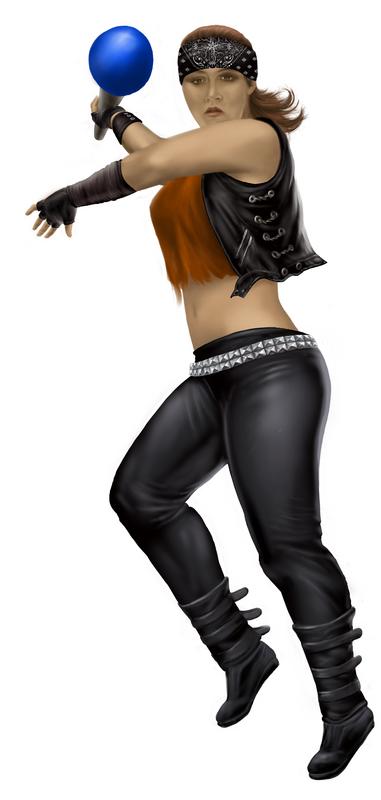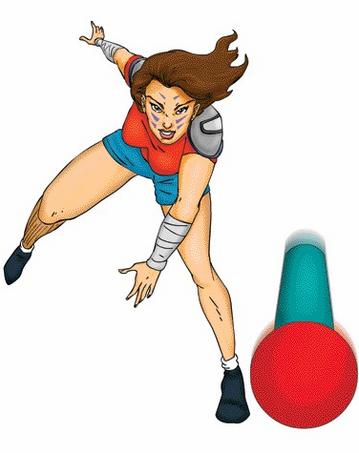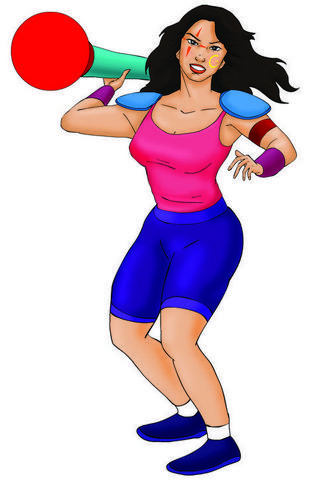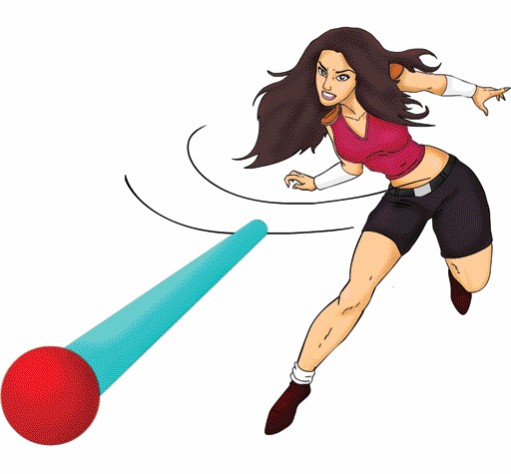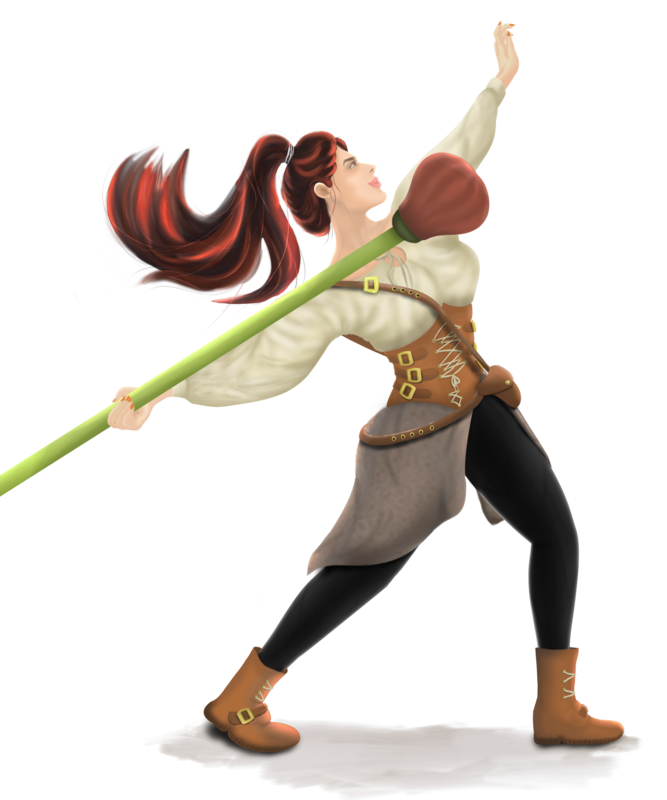The Rule Book Page Five (5)
Polearmball the Difference:
Polearmball introduces new skills which are unheard of and unpracticed in present day mainstream sports. Polearmball also introduces new equipment not typically seen in team sports.
Polearmball uses two objects with which to score points. In Basketball, or baseball, or soccer, only one object is actually used to score points. In Polearmball both the ball and the polearm in their own right may be used to score points. Whether a team possesses the polearmball or the polearm, points may be scored by either team during the same round.
The polearmball (ball) is also a new device in that it is a unique ball with a unique shape and feel. The polearmball represents a sack in the role playing aspect of the game and is shaped so as to simulate a sack filled with food and supplies. In the role playing aspect of the game inside the sack are the virtual goods that the warrior will try to supply his village with.
In Polearmball a Runner may run to either side of the field to score a delivery and thereby score points. He/she may change direction on the field at will before deciding which delivery line he/she will cross. Other mainstream team sports delegate one side of the field as the scoring end. Not so in Polearmball.
The polearm called a Javel is a new sports device. The skill sets needed in Polearmball to handle the polearm as a team are new. Points may be scored by using the polearm to hit a moving human target. Points may also be scored by using the polearm to hit a moving innate target which under certain circumstances during the game is the polearmball when it is airborne or during a Toss-Up. Points may also be scored by using the polearm to hit another innate object which would be the targets at either end of the playing field.
However, in Polearmball when an opponent hits a target after a Runner makes a Delivery then points that would have been scored for a Delivery by the Runner are cut in half. In the role playing aspect of the game the Runner who fails to protect his/her village (the Target) from assault after a successful Delivery and allows the polearm to hit the Target has also allowed the Delivery and village to be damaged by the enemy. It is the Runner's job to attempt to block an incoming polearm from hitting the Target after scoring a Delivery.
Polearmball is a sport which allows teams to score points during both defense and offense and points may also be mitigated or reduced such as when the Target is hit after a Delivery.
Due to the nature of hitting moving human targets it follows that the smaller the target the harder and more challenging it becomes to hit that target. Hence, Polearmball is conducive to short athletes. This is a first. Short athletes may now garner status and notoriety by way of their stature. Instead of being a handicap it is a stand out trait. In real life both in war and in the hunt for food, short stature has been an advantage in many circumstances. Polearmball showcases this point and views short stature as an advantage. The result is that in order to even-out the odds of winning, teams will need to balance the members of their team with an equal quantity of tall players (who are easier to hit) with the quantity of short players. If a team has ten members, five ought to be tall and five ought to be short. The taller players will have an advantage over polearm skills and short players will have an advantage over running skills.
Entertainment:
Polearmball is also an entertainment sport whereby team players are rewarded for meeting certain performance criteria. Unlike diving or gymnastics which are more of individual sports than team sports, Polearmball is a team sport that uses performance criteria to contribute to the team score.
At the beginning of a round the Runner starts inside the Midfield Circle. A designated Polearmist starts outside the circle. The Runner at his option may remain inside the circle for up to sixty (60) seconds. During the time that the Runner remains inside the Midfield Circle for up to sixty (60) seconds, the Polearmist may intimidate the runner and opposing team by skillful displays of acrobatic stunts and by twirling the polearm and adding the use of his/her voice to shout. The Polearmist is also graded for the look of his/her face and body using war paint and for his/her fashion-wear that compliments his/her tribe, clan, gang, or family theme.
It is the duty of the Polearmist at the beginning of each round who starts the round while being in possession of the polearm to intimidate the Runner and intimidate the opposing team with bravado and skill. The Polearmist (player in possession of the polearm) scores performance points at the beginning of each round for performing skills using the polearm as a prop. The Polearmist may choose to demonstrate an array of maneuvers for up to 60 seconds until the runner makes his move to begin his/her run.
The Polearmist will be graded upon five (5) criteria for up to sixty (60) seconds and will be judged for his/her excellence by an official.
The criteria are: (A) Difficulty of Stunts, (B) Effective Voice, (C) How well the Uniform or garb conforms to team’s theme and intimidates the opposition, (D) Facial Gestures and War Paint, and (E) General Impact of Intimidation which may be compromised if the performance is brief due to the Runner escaping from the Midfield Circle early.
The Polearmist will win up to three (3) points for each category. A score of one (1) means acceptable. A score of two (2) means the criteria was outstanding or extraordinary. A score of three (3) means the criteria was sensational in a way that is almost inhuman as only an elite or Olympic athlete would be able to achieve. It is also possible to score a zero (0) if the criteria were unacceptable or non-existent. If the Polearmist manages to contain the runner within the Midfield Circle for the entire sixty (60) seconds allotted then he/she will earn a five (5) point bonus. The total performance score possible is twenty (20) points if the bonus is achieved.
In this image we see the game is starting out and the Polearmist is engaged in the performance ritual. The Runner has up to sixty (60) seconds to run out of the circle before the other players are free to come into the game.
Here we see another view of the performance ritual at the beginning of a round. The Polearmist is shown performing polearm maneuvers and acrobatic jumps.
Big or Small - Tall or Short
Along with new strategies and new skills and new devices not familiar to mainstream sports, it doesn’t end there. There is an advent to this sport that is unique and conducive to shorter athletes as well as taller athletes. Shorter athletes are elusive targets due to their small size which facilitates avoiding a hit from an airborne polearm. Larger athletes will be easier targets to hit. This translates into a team whose winning strategy will be to conform to a balance of small players and large players. Hence Polearmball is a team sport whereby both tall athletes and short athletes are essential.
Again, due to the nature of hitting moving human targets it follows that the smaller the target the harder and more challenging it becomes to hit that target. Polearmball is therefore conducive to athletes with a short stature. This is a first. Short athletes may now garner status and notoriety by way of stature. Instead of being a handicap it is a stand out trait. In real life both in war and in the ancient hunt for food, short stature has been an advantage in many circumstances. Polearmball reflects this point and capitalizes upon this advantage. The result is that in order to balance out the odds of winning, teams must balance the members of their team with an equal quantity of taller players (who are easier to hit) with the quantity of shorter players (who are hard targets). If a team has ten members, five ought to be tall and five ought to be short.
Females
Polearmball is a coed sport.
In the role playing aspect of the game Polearmball honors history in acknowledging women's role next to men in battle and in the ancient hunt for food and supplies, or to bring home the bacon in modern times. Instead of brawn it is athleticism and skill in the way of tactics, speed, agility, acrobatics, and team effort which determines success. The game is genteel in a way that the brawn of males is not a deciding factor over which team is more likely to win. Hence along with short athletes, females as in the real world throughout history may participate along side males in the hunt or battle.
According to the statistics throughout history indicating that there were less females than males involved in the struggle to physically battle in wars and hunt game, Polearmball also reflects the lesser female to male ratio. Teams may have female members as warriors but unless the team is all females then they shall conform to the following limits...
Four (4) to Six (6) members, One (1) may be female.
Seven (7) to (9) members, Two (2) may be female.
Ten (10) to Twelve (12) members, Three (3) may be female.
Thirteen (13) to Fifteen (15) members, Four (4) may be female.
Sixteen (16) to Eighteen (18) members, Five (5) may be female.
Ninteen (19) to Twenty (20) members, Six (6) may be female.
You are on Page 5
In this image the Runner has failed to protect his village. The Runner's Delivery is damaged. The Runner's Village is Damaged. The Delivery score is cut in half.
Short Stature
Normal Stature
This is a scene that shows the Polearmist at the beginning of a round tricking by performing a variation of a Corkscrew
Family
Clan
Gang
Tribe
The Runner will also entertain the spectators during his/her run by his skill as he/she avoids obstacle lines or blockades formed by the interlocking players who try to trap the Runner so as to create a shot for the Polearmist to either spear (throw) the polearm or joust (jab with the polearm) the Runner.
It is natural that once these polearm skills, and acrobatic maneuvers, and face painting expertise, and Kiai are proficient then the players will perform these skills even in the normal course of the game even after the showdown between the starting Polearmist and Runner is finished.
Polearmball will hence serve as a showcase for performance skills which entertain both the doer and the spectators.
The Runner may vault, flip, or jump over (Parkour) the obstacle lines of opponents who are trying to get in his/her way. However, the interlocked opponents may circle back around and encapsulate the Runner as he/she lands on the other side of the line if the line acts quickly. The inherent nature of the game is to entertain the audience with showmanship.
During the ensuing round of play after the showdown between the starting Polearmist and the Runner, the Polearmist’s performance score will be tallied and posted so that the players may see the points awarded to the offense before a Delivery is made by the Runner (defense). It is possible for the Polearmist to earn more points than what a Delivery is worth. If the Runner manages to run out of the Midfield Circle early then the Polearmist’s performance will be cut short and his subsequent score may be compromised.
